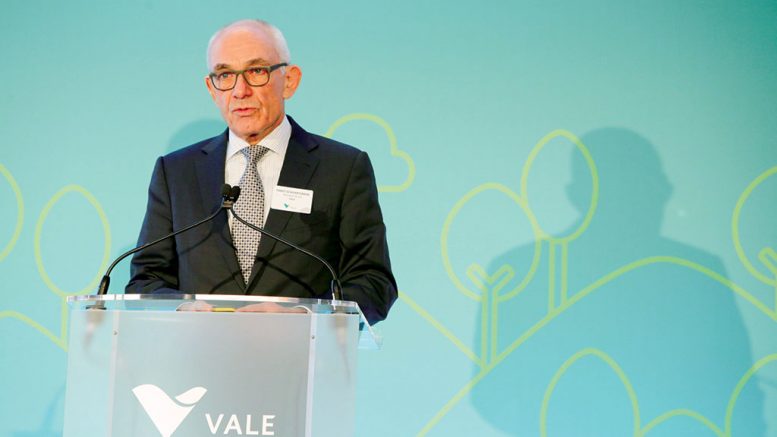State prosecutors in Brazil have charged Vale’s (NYSE: VALE) former CEO, Fabio Schvartsman, with homicide after the catastrophic tailings dam disaster a year ago at the company’s Feijao iron ore mine in Minas Gerais killed more than 250 people. Schvartsman left his position at the company in March 2019.
Homicide charges also have been levelled against 15 other people, according to a charging sheet seen by Reuters, while state prosecutors have charged Vale and its German contractor TUV SUD with environmental crimes.
Vale did not return a request from The Northern Miner for clarification on the charges, but in a statement on its website said it “believes the accusations of fraud are perplexing” and that “it is important to note that other authorities are investigating the case, and, at this point, it is premature to claim there was conscious assumption of risk to cause a deliberate breach of the dam.
“Vale trusts in the complete clarification of the causes of the breach and reaffirms its commitment to continue to fully cooperate with the authorities,” it said.

Destruction caused by spilled tailings from the Feijao iron ore mine in January 2019. Credit: Felipe Werneck/Ibama.
In mid-December, the mining giant released a long-awaited report from a panel of experts on the technical causes of the dam failure at the mine in Brumadinho. The report found that the failure was “unique in that it occurred with no apparent signs of distress prior to failure.”
The report also stated that “analyses of the stress state within the dam showed that parts of the dam were under very high loading due to the steepness of the dam, the heavy weight of the tailings and the high internal water level. The combination of a steep upstream-constructed dam, high water level, weak fine tailings within the dam, and the brittle nature of the tailings created the conditions for failure.”
The tailings dam failure on Jan. 25 killed 257 people and left 13 others missing for an assumed death toll of 270.
“The report does not attribute blame but looks at what occurred,” Edward Sterck of BMO Capital Markets said in a research note to clients on Dec. 12, 2019. “The key conclusion is that the dam design, a lack of internal drainage and poor tailings deposition management throughout the life of the dam were the root causes. Our interpretation is that the dam would have been close to its failure envelope through most of its existence.”
The disaster has been described as a “human and environmental tragedy” by the Global Tailings Review, an initiative of the International Council on Mining and Metals, the United Nations Environment Programme and the Principles for Responsible Investment.
When the dam collapsed, 11.7 million cubic metres of mining waste plowed through the mine site towards the local town and countryside below.

Destruction caused by spilled tailings from the Feijao iron ore mine in January 2019. Credit: Felipe Werneck/Ibama.
“This is a stark reminder that, while the mining and metals industry has come a long way improving how it operates, there’s still much more that can be done to safeguard lives, improve performance and demonstrate transparency,” stated the Global Tailings Review, which is working on new global standards for the safer management of tailings storage facilities.
Adam Matthews, director for ethics and engagement for the Church of England Pensions Board and cochair of the Global Mining & Tailings Safety Initiative, has called for the creation of an independent round-the-clock alert system for all tailings dams globally. “Much more needs to still be done and removal of the most dangerous dams has to also be the immediate priority,” he said on Jan. 24 — the eve of the one-year anniversary of the tailings dam failure in 2019.
The Global Mining & Tailings Safety Initiative, a group supported by over 100 institutions with more than US$14 trillion in assets under management, and co-led by the Church of England Pensions Board and the Council of Ethics of the Swedish National Pension Fund, also announced the launch of the first-ever publicly accessible global database of tailings storage facilities.

Destruction caused by spilled tailings from the Feijao iron ore mine in January 2019. Credit: Felipe Werneck/Ibama.
The database contains 1,939 tailings facilities that have been disclosed by 98 mining companies. The companies make up 54% of the global mining industry by market capitalization.
According to the database, the disclosed facilities contain 45.7 billion cubic metres of tailings by volume — or 11,447 Wembley stadiums — a football stadium in London that is England’s largest, with 90,000 seats.






Be the first to comment on "Ex-Vale CEO charged with homicide for Brazil dam disaster"